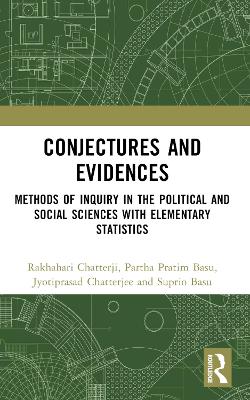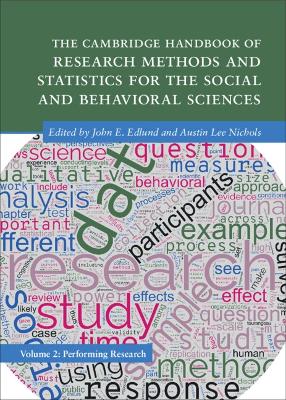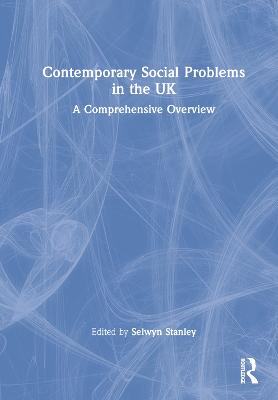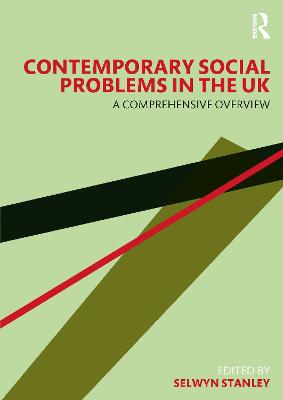Conjectures and Evidences
 portes grátis
portes grátis
Conjectures and Evidences
Methods of Inquiry in the Political and Social Sciences with Elementary Statistics
Chatterjee, Jyotiprasad; Basu, Suprio; Chatterji, Rakhahari; Basu, Partha Pratim
Taylor & Francis Ltd
11/2024
380
Mole
9781032526843
Pré-lançamento - envio 15 a 20 dias após a sua edição
Descrição não disponível.
Preface
List of Tables
List of Figures
PART I
1. Research Srategies: Quantitative and Qualitative
Theory, Epistemological Concerns and Ontological Questions
Trajectories of Quantitative and Qualitative Research
Data and Data Collection Techniques in Quantitative and Qualitative Research
Major Preoccupations of Quantitative and Qualitative Researchers
Critique of Quantitative and Qualitative Research
2. Research Methodology: Concepts Hypotheses and Variables
Why learn methodology?
Concepts, Hypotheses and Variables
3. Research Designs: Experimental and Quasi Experimental
J.S. Mill and the Experimental Method
The Experiment
Experimental Designs
Quasi-Experimental Designs
4. Aggregate Data Analysis
What are Aggregate Data?
Sources of Aggregate Data?
Uses of Aggregate Data
Analysis of Aggregate Data
5. Survey Research: Data and Analysis
Definition, Origin and Development of Survey Research
Techniques of Survey Research
Survey Data Analysis
Problems and Limitations of Survey Research
Conclusions: Some Solutions to the Problem of Survey Research
6. Content Analysis
History of Content Analysis
Definition and Nature of Content Analysis
Description of the Technique
Examples of Content Analysis
Qualitative-Quantitative Continuum in Content Analysis
Assessment of Content Analysis
7. The Logic and the Practice of Participant Observation
Meaning Understanding and Sociology
Meaning Understanding and Social Anthropology
Participation and Understanding the Political Process
Participant Observation: How to Practice It
8. Focus Group Research
History of Focus Group Research
Nature and Types of Focus Group Research
Description of the Technique
Examples of Focus Group Research
Focus Group Discussion as a Standalone Method?
Focus Group, Participant Observation and Interview: A Comparative Assessment
PART II
9. Measurement: the Cornerstone of Research
Levels or Scales of Measurement:
Nominal scale
Ordinal scale
Interval scale
Ratio scale
10. Organizing the Data: Frequency Distribution
Frequency Distribution of Nominal Data
Frequency Distribution of Ordinal Data
Frequency Distribution of Interval/Ratio Data
Cumulative Frequency and Cumulative Percentage
Application of the Method of Simple Interpolationxi
11. Measures of Central Tendency
Mode,
Median (Quartiles, Deciles, Percentiles)
Arithmetic Mean
Choosing an Appropriate Measure of Central Tendency
Exercise
12. Measures of Dispersion
Range
Mean Deviation
Quartile Deviation
Standard Deviation
Selecting the Best Measure of Dispersion
Relative Measures of Dispersion
Skewness
Exercise
13. Correlation and Regression
Strength of Association
Direction of Association
Correlation Coefficient
Regression
Properties of Linear Regression
Exercise
14. Nonparametric Measures of Correlation
Spearman's Rank Correlation Coefficient
Phi Correlation Coefficient
Chi Square
Contingency Correlation Coefficient
Cramer's V
Exercise
List of Important Formulas
Bibliography
Index
List of Tables
List of Figures
PART I
1. Research Srategies: Quantitative and Qualitative
Theory, Epistemological Concerns and Ontological Questions
Trajectories of Quantitative and Qualitative Research
Data and Data Collection Techniques in Quantitative and Qualitative Research
Major Preoccupations of Quantitative and Qualitative Researchers
Critique of Quantitative and Qualitative Research
2. Research Methodology: Concepts Hypotheses and Variables
Why learn methodology?
Concepts, Hypotheses and Variables
3. Research Designs: Experimental and Quasi Experimental
J.S. Mill and the Experimental Method
The Experiment
Experimental Designs
Quasi-Experimental Designs
4. Aggregate Data Analysis
What are Aggregate Data?
Sources of Aggregate Data?
Uses of Aggregate Data
Analysis of Aggregate Data
5. Survey Research: Data and Analysis
Definition, Origin and Development of Survey Research
Techniques of Survey Research
Survey Data Analysis
Problems and Limitations of Survey Research
Conclusions: Some Solutions to the Problem of Survey Research
6. Content Analysis
History of Content Analysis
Definition and Nature of Content Analysis
Description of the Technique
Examples of Content Analysis
Qualitative-Quantitative Continuum in Content Analysis
Assessment of Content Analysis
7. The Logic and the Practice of Participant Observation
Meaning Understanding and Sociology
Meaning Understanding and Social Anthropology
Participation and Understanding the Political Process
Participant Observation: How to Practice It
8. Focus Group Research
History of Focus Group Research
Nature and Types of Focus Group Research
Description of the Technique
Examples of Focus Group Research
Focus Group Discussion as a Standalone Method?
Focus Group, Participant Observation and Interview: A Comparative Assessment
PART II
9. Measurement: the Cornerstone of Research
Levels or Scales of Measurement:
Nominal scale
Ordinal scale
Interval scale
Ratio scale
10. Organizing the Data: Frequency Distribution
Frequency Distribution of Nominal Data
Frequency Distribution of Ordinal Data
Frequency Distribution of Interval/Ratio Data
Cumulative Frequency and Cumulative Percentage
Application of the Method of Simple Interpolationxi
11. Measures of Central Tendency
Mode,
Median (Quartiles, Deciles, Percentiles)
Arithmetic Mean
Choosing an Appropriate Measure of Central Tendency
Exercise
12. Measures of Dispersion
Range
Mean Deviation
Quartile Deviation
Standard Deviation
Selecting the Best Measure of Dispersion
Relative Measures of Dispersion
Skewness
Exercise
13. Correlation and Regression
Strength of Association
Direction of Association
Correlation Coefficient
Regression
Properties of Linear Regression
Exercise
14. Nonparametric Measures of Correlation
Spearman's Rank Correlation Coefficient
Phi Correlation Coefficient
Chi Square
Contingency Correlation Coefficient
Cramer's V
Exercise
List of Important Formulas
Bibliography
Index
Este título pertence ao(s) assunto(s) indicados(s). Para ver outros títulos clique no assunto desejado.
Research Srategies;Research Designs;Aggregate Data Analysis;Survey Research;CSDS Lokniti;Tamil Nadu;Pearson's Measure;Vice Versa;Data Set;Grouped Frequency Distribution;Social Science Research;Interrupted Time Series Design;Phi Correlation;Cumulative Frequency Column;Ordinal Level Data;Quantitative Research;Quartile Deviation;Multiple Time Series Design;Ratio Level Data;Covariance Xy;Phi Coefficient;Class Intervals;Pre Test Post Test Design;Spearman's Rank Correlation;Lower Class Limit;Classical Experimental Design;Cumulative Frequency;Focus Group Research
Preface
List of Tables
List of Figures
PART I
1. Research Srategies: Quantitative and Qualitative
Theory, Epistemological Concerns and Ontological Questions
Trajectories of Quantitative and Qualitative Research
Data and Data Collection Techniques in Quantitative and Qualitative Research
Major Preoccupations of Quantitative and Qualitative Researchers
Critique of Quantitative and Qualitative Research
2. Research Methodology: Concepts Hypotheses and Variables
Why learn methodology?
Concepts, Hypotheses and Variables
3. Research Designs: Experimental and Quasi Experimental
J.S. Mill and the Experimental Method
The Experiment
Experimental Designs
Quasi-Experimental Designs
4. Aggregate Data Analysis
What are Aggregate Data?
Sources of Aggregate Data?
Uses of Aggregate Data
Analysis of Aggregate Data
5. Survey Research: Data and Analysis
Definition, Origin and Development of Survey Research
Techniques of Survey Research
Survey Data Analysis
Problems and Limitations of Survey Research
Conclusions: Some Solutions to the Problem of Survey Research
6. Content Analysis
History of Content Analysis
Definition and Nature of Content Analysis
Description of the Technique
Examples of Content Analysis
Qualitative-Quantitative Continuum in Content Analysis
Assessment of Content Analysis
7. The Logic and the Practice of Participant Observation
Meaning Understanding and Sociology
Meaning Understanding and Social Anthropology
Participation and Understanding the Political Process
Participant Observation: How to Practice It
8. Focus Group Research
History of Focus Group Research
Nature and Types of Focus Group Research
Description of the Technique
Examples of Focus Group Research
Focus Group Discussion as a Standalone Method?
Focus Group, Participant Observation and Interview: A Comparative Assessment
PART II
9. Measurement: the Cornerstone of Research
Levels or Scales of Measurement:
Nominal scale
Ordinal scale
Interval scale
Ratio scale
10. Organizing the Data: Frequency Distribution
Frequency Distribution of Nominal Data
Frequency Distribution of Ordinal Data
Frequency Distribution of Interval/Ratio Data
Cumulative Frequency and Cumulative Percentage
Application of the Method of Simple Interpolationxi
11. Measures of Central Tendency
Mode,
Median (Quartiles, Deciles, Percentiles)
Arithmetic Mean
Choosing an Appropriate Measure of Central Tendency
Exercise
12. Measures of Dispersion
Range
Mean Deviation
Quartile Deviation
Standard Deviation
Selecting the Best Measure of Dispersion
Relative Measures of Dispersion
Skewness
Exercise
13. Correlation and Regression
Strength of Association
Direction of Association
Correlation Coefficient
Regression
Properties of Linear Regression
Exercise
14. Nonparametric Measures of Correlation
Spearman's Rank Correlation Coefficient
Phi Correlation Coefficient
Chi Square
Contingency Correlation Coefficient
Cramer's V
Exercise
List of Important Formulas
Bibliography
Index
List of Tables
List of Figures
PART I
1. Research Srategies: Quantitative and Qualitative
Theory, Epistemological Concerns and Ontological Questions
Trajectories of Quantitative and Qualitative Research
Data and Data Collection Techniques in Quantitative and Qualitative Research
Major Preoccupations of Quantitative and Qualitative Researchers
Critique of Quantitative and Qualitative Research
2. Research Methodology: Concepts Hypotheses and Variables
Why learn methodology?
Concepts, Hypotheses and Variables
3. Research Designs: Experimental and Quasi Experimental
J.S. Mill and the Experimental Method
The Experiment
Experimental Designs
Quasi-Experimental Designs
4. Aggregate Data Analysis
What are Aggregate Data?
Sources of Aggregate Data?
Uses of Aggregate Data
Analysis of Aggregate Data
5. Survey Research: Data and Analysis
Definition, Origin and Development of Survey Research
Techniques of Survey Research
Survey Data Analysis
Problems and Limitations of Survey Research
Conclusions: Some Solutions to the Problem of Survey Research
6. Content Analysis
History of Content Analysis
Definition and Nature of Content Analysis
Description of the Technique
Examples of Content Analysis
Qualitative-Quantitative Continuum in Content Analysis
Assessment of Content Analysis
7. The Logic and the Practice of Participant Observation
Meaning Understanding and Sociology
Meaning Understanding and Social Anthropology
Participation and Understanding the Political Process
Participant Observation: How to Practice It
8. Focus Group Research
History of Focus Group Research
Nature and Types of Focus Group Research
Description of the Technique
Examples of Focus Group Research
Focus Group Discussion as a Standalone Method?
Focus Group, Participant Observation and Interview: A Comparative Assessment
PART II
9. Measurement: the Cornerstone of Research
Levels or Scales of Measurement:
Nominal scale
Ordinal scale
Interval scale
Ratio scale
10. Organizing the Data: Frequency Distribution
Frequency Distribution of Nominal Data
Frequency Distribution of Ordinal Data
Frequency Distribution of Interval/Ratio Data
Cumulative Frequency and Cumulative Percentage
Application of the Method of Simple Interpolationxi
11. Measures of Central Tendency
Mode,
Median (Quartiles, Deciles, Percentiles)
Arithmetic Mean
Choosing an Appropriate Measure of Central Tendency
Exercise
12. Measures of Dispersion
Range
Mean Deviation
Quartile Deviation
Standard Deviation
Selecting the Best Measure of Dispersion
Relative Measures of Dispersion
Skewness
Exercise
13. Correlation and Regression
Strength of Association
Direction of Association
Correlation Coefficient
Regression
Properties of Linear Regression
Exercise
14. Nonparametric Measures of Correlation
Spearman's Rank Correlation Coefficient
Phi Correlation Coefficient
Chi Square
Contingency Correlation Coefficient
Cramer's V
Exercise
List of Important Formulas
Bibliography
Index
Este título pertence ao(s) assunto(s) indicados(s). Para ver outros títulos clique no assunto desejado.
Research Srategies;Research Designs;Aggregate Data Analysis;Survey Research;CSDS Lokniti;Tamil Nadu;Pearson's Measure;Vice Versa;Data Set;Grouped Frequency Distribution;Social Science Research;Interrupted Time Series Design;Phi Correlation;Cumulative Frequency Column;Ordinal Level Data;Quantitative Research;Quartile Deviation;Multiple Time Series Design;Ratio Level Data;Covariance Xy;Phi Coefficient;Class Intervals;Pre Test Post Test Design;Spearman's Rank Correlation;Lower Class Limit;Classical Experimental Design;Cumulative Frequency;Focus Group Research







